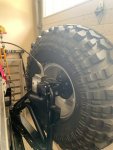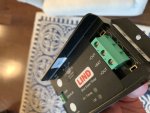ccg_ga
Member
The timer has the relay built in. Bypass the relay completely, remove it.
Got it, that makes sense now that I think about it. I ordered the SDT1230-014 model directly from Lind.
In removing the relay I'll need to join the 8 ga positive battery wire that ran to pins 30 and 87 on the relay. While I know it's not optimal, I am thinking that I will use copper butt terminals to connect the two runs and top them off with marine heat shrink and adjust the flex tubing accordingly. Otherwise I would need to pull the wire out and re-run it, redo the spiral wrap/flex tubing, firewall entry, etc. Is this a horrible idea or should I just re-run it instead?
Those antennas are beasts. And not in a good way. The base is very wide and sticks up quite a bit. If it hits a branch, something is going to break. Might be the branch, might be the antenna, might be the mount. If you go with that antenna, keep it down low so the spring will protect the whip. Keep the base down out of the way.
Or, better yet, go with the Larsen with the spring base lower down.
You want to keep it as far away from your transmit antennas as possible. As @mmckenna said, you're running out of room.
Will it will be far less than optimal, will your SDS 100 receive what you want using the stock rubber duckie antenna on the radio inside the vehicle? If that will give you acceptable performance, you'd have one less mounting problem and that would mitigate RF overload.
I think I got a little excited about adding the scanner antenna. I didn't realize that the Larsen NMO 150/450/758 had a spring base from the pictures I was looking at on Antenna Farm. I looked at the ArcAtenna site earlier and realized that it indeed does.
So in comparing the bands the 150/450/758 to the bands I want to monitor it likes up really well with the exception of a gap between 406 and 430 (where the antenna is tuned for 430-520). Most of what I was interested in monitoring between 406-430 are national interop, federal disaster management and SAR and some of the national parks in the southeast are on those frequencies. That being said, does it in reality not really matter that the antenna is "tuned" for 406-430 and what I will actually receive provided there are strong signals? That whole thing may be a wash and the 150/450/758 is the antenna to go with.
I see the 150/450/758 is 16.5", so even if I mount it on the top of the tire carrier like I was thinking about it will still be almost totally covered by the spare tire and won't rise above the roof line. Will this impact RX significantly, or given the options (or lack thereof) will the antenna perform decently well for RX? I could still rig up the mount I was thinking about to extend slightly above the roof line since the antenna does have the spring base.
And last one on this - does ground plane matter for RX only? I have read several threads on this and some say yes, some say no. I wasn't sure which one was more accurate.
Thanks for the continue help gents, it is much appreciated.



